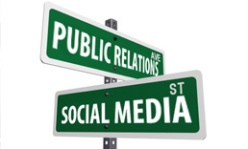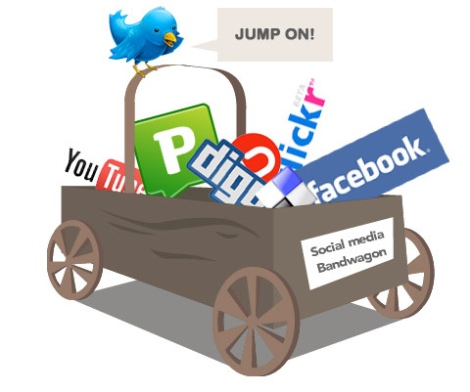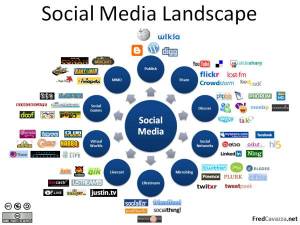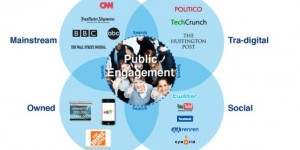What makes you or your firm different from the others? Does the world know that you exist? Who are your major influencers in the market and what does your existing audience think of you? You make a mark only when you create a platform for yourself and your firm. From time immemorial, communication has grown in leaps and bounds and so have the companies in the market. The two main motives of starting a firm are to increase service and have a consistent income or in laymen terms, have profits. Initially, the ideas were to get what we have invested and the second to gain profits on what we have invested. My article this time is about return on investment in social media.
I found this interesting picture online. Return on investments, as investopedia defines is ,” a performance measure used to evaluate the efficiency of an investment or to compare the efficiency of a number of different investments. To calculate ROI, the benefit (return) of an investment is divided by the cost of the investment; the result is expressed as a percentage or a ratio.”
The return on investments formula: The return on investment’s formula:
![]()
Applicable to all investments, ROI is mandatory for every business. Social media is good form of measuring the investment. Through sites like facebook, twitter, pinterest and other progressive sites under the domain of social media, experts can calculate the interest rates of audience. Every likes, comment, share, pin, retweet etc counts. The number of likes helps understand the research of the product, share helps us with the spread of the idea, comment with analyzing the thought and retweet with the element of interest. The better the news, the more likely it is to be shared. Pictures make good impact with respect to generating interest. It is ideal to use tools of this sort to measure success. Visual approach can help bring more awareness amongst the audience. Coca Cola for instance has been in the market for over a century. It has brought about change in the way its consumer thinks. Every season they have a background and come out with so classic tagline to hold on to the trust. Their reign over the market continues as they have complete control over their audience. In my opinion, a good business can be built on the bases of trust and good will. Instead of pulling audience to their side, Coca Cola came to the source where their audience is present. Little did they know, that they would join the league of companies that are most watched on the internet. Other companies include starbucks, zappos, hp, ford etc.
Giving discounts, coupons and other promotional material have paved way for new generational ideas. Gone are the days when consumers scanned to the newspaper to get discounted and subsidized goods. In a country like India, the future of social media has a long way to go. Even governmental schemes are put up on their websites for promotions. The target audience is reduced to illiterate and unaware population. A huge chunk of the populations depends on television as a source of building awareness.
Expanding audience base on web has undergone substantial change over the years. From the traditional email to pining your interest, it is evident that the gap is equivalent to a generational. Today, not many read their emails unless necessary. Where as many make it a point to check their social media accounts atleast once in a day. Almost all known companies in the market have created accounts on social media sites to get closer to audience.
The article Social Media ROI – How to Achieve: User Engagement With Your Brand (http://www.business2community.com/social-media/social-media-roi-how-to-achieve-user-engagement-with-your-brand-0422877#y21V0vwXsg58pwPv.99) emphasizes on the many mediums that a firm could use to increase their audience base. Are you creator or a experiencer? It is essential for a firm to get into the shoes of an audience at times to experience what they are. The article also talks about how social media has become an instrument that cannot be avoided while promoting. Another factor mentioned in the article is generate interest through posing questions, expressing concerns, asking for feedback, encouraging to share, visual portrayal etc.
On the contrary, I couldn’t agree more with the article written by Spencer Richardson in his article, “How valuable is social media audience, really?”, which raises a debate as to whether audience on social media are really influenced or no. (http://mashable.com/2012/12/01/maximize-audience-value/ ). For many this might be just another way of communicating and promotion. The author observes, ” A major challenge facing marketers is working with environments where they don’t actually own their audience; rather they are merely renting those relationships. This difficulty is not by accident. It’s a manufactured problem stemming from the competing interests of the social media platforms on which audiences are being built”. The conventional form of communicating over the internet through email still remains the primary access point for many consumers. Majority of consumer thought is based on what they watch the most which in turn goes around in their mind. Innovation on web is the primary source of increasing audience.
Social media gurus observe that scheduling your content before hand which is inline with the popular talk can gauge audience interest. Building an effective return on investment in social media plan is like designing a speakers bureau plan. Both need training and strategizing. Nichole Kelley, author of “How to measure social media ” expresses her views by saying that over the year marketers have defined social media in different ways. In an interview with socialmediaexaminer.com, ” Nichole believes one of the reasons social ROI is a challenge is because marketers have redefined the metrics used to measure social media. Words such as mentions and retweets are similar to what was measured before. But now people have decided that social media is special, and therefore needs to be measured in a special way”. I agree with her on this point. For any measurement, it is important for the company to focus on the doable as well as the risk that can been foreseen.
Keeping all of the above in mind, even though return on investment is an essential factor for firms that use social media, it is not a necessary factor to invest only in social media. Applications like google analytic wildfire, Interactive, buddymedia etc. can help with measuring. In the ocean called business, social media is an island. Innovation is the key to creating ideas and awareness among audience.
Applicable to all investments, ROI is mandatory for every business. Social media is good form of measuring the investment. Through sites like facebook, twitter, pinterest and other progressive sites under the domain of social media, experts can calculate the interest rates of audience. Every likes, comment, share, pin, retweet etc counts. The number of likes helps understand the research of the product, share helps us with the spread of the idea, comment with analyzing the thought and retweet with the element of interest. The better the news, the more likely it is to be shared. Pictures make good impact with respect to generating interest. It is ideal to use tools of this sort to measure success. Visual approach can help bring more awareness amongst the audience. Coca Cola for instance has been in the market for over a century. It has brought about change in the way its consumer thinks. Every season they have a background and come out with so classic tagline to hold on to the trust. Their reign over the market continues as they have complete control over their audience. In my opinion, a good business can be built on the bases of trust and good will. Instead of pulling audience to their side, Coca Cola came to the source where their audience is present. Little did they know, that they would join the league of companies that are most watched on the internet. Other companies include starbucks, zappos, hp, ford etc.
Giving discounts, coupons and other promotional material have paved way for new generational ideas. Gone are the days when consumers scanned to the newspaper to get discounted and subsidized goods. In a country like India, the future of social media has a long way to go. Even governmental schemes are put up on their websites for promotions. The target audience is reduced to illiterate and unaware population. A huge chunk of the populations depends on television as a source of building awareness.
Expanding audience base on web has undergone substantial change over the years. From the traditional email to pining your interest, it is evident that the gap is equivalent to a generational. Today, not many read their emails unless necessary. Where as many make it a point to check their social media accounts at least once in a day. Almost all known companies in the market have created accounts on social media sites to get closer to audience.
The article Social Media ROI – How to Achieve: User Engagement With Your Brand (http://www.business2community.com/social-media/social-media-roi-how-to-achieve-user-engagement-with-your-brand-0422877#y21V0vwXsg58pwPv.99) emphasizes on the many mediums that a firm could use to increase their audience base. Are you creator or a experiencer? It is essential for a firm to get into the shoes of an audience at times to experience what they are. The article also talks about how social media has become an instrument that cannot be avoided while promoting. Another factor mentioned in the article is generate interest through posing questions, expressing concerns, asking for feedback, encouraging to share, visual portrayal etc.
On the contrary, I couldn’t agree more with the article written by Spencer Richardson in his article, “How valuable is social media audience, really?”, which raises a debate as to whether audience on social media are really influenced or no. (http://mashable.com/2012/12/01/maximize-audience-value/ ). For many this might be just another way of communicating and promotion. The author observes, ” A major challenge facing marketers is working with environments where they don’t actually own their audience; rather they are merely renting those relationships. This difficulty is not by accident. It’s a manufactured problem stemming from the competing interests of the social media platforms on which audiences are being built”. The conventional form of communicating over the internet through email still remains the primary access point for many consumers. Majority of consumer thought is based on what they watch the most which in turn goes around in their mind. Innovation on web is the primary source of increasing audience.
Social media gurus observe that scheduling your content before hand which is inline with the popular talk can gauge audience interest. Building an effective return on investment in social media plan is like designing a speakers bureau plan. Both need training and strategizing. Nichole Kelley, author of “How to measure social media ” expresses her views by saying that over the year marketers have defined social media in different ways. In an interview with socialmediaexaminer.com, ” Nichole believes one of the reasons social ROI is a challenge is because marketers have redefined the metrics used to measure social media. Words such as mentions and retweets are similar to what was measured before. But now people have decided that social media is special, and therefore needs to be measured in a special way”. I agree with her on this point. For any measurement, it is important for the company to focus on the doable as well as the risk that can been foreseen.
Keeping all of the above in mind, even though return on investment is an essential factor for firms that use social media, it is not a necessary factor to invest only in social media. Applications like google analytic wildfire, Interactive, buddymedia etc. can help with measuring. In the ocean called business, social media is an island. Innovation is the key to creating ideas and awareness among audience.







